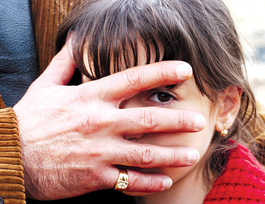home | north bay bohemian index | movies | current reviews | film review

LA FAMIGLIA: Miriana Faja portrays Rita Atria as a child.
Dead Girl Walking
'Sicilian Girl' follows the clockwork of ultimate betrayal
By Richard von Busack
Compelling but rather awkward, The Sicilian Girl is based on the story of Rita Atria, an important witness against the Mafia during the Italian government's campaign against the crime families in the early 1990s. Atria's story is not a happy one. Despite the fact that her brother and her father were murdered by mobsters, her own mother turns against her for involving the hated police. (The final image of the mother's revenge against her daughter, which seems unthinkably melodramatic, is a true story.)
What works and what doesn't work in Sicilian director Marco Amenta's film separates like oil and vinegar. Amenta previously made a documentary using passages from Atria's diary, the source for some of the dialogue here. It's rare to be able to improve on material that's covered in that form, and to successfully take it into the realm of fiction.
Ultimately, The Sicilian Girl shines because of its star. As 17-year-old Rita, Veronica d'Agostino is an unusual actress. She's a plain, stocky girl with a big jaw who dresses in conservative black, even when she's in witness protection in Rome. D'Agostino is the type we don't get in the movies much since Minnie Driver stopped getting lead roles. She's believable as a girl of great purpose, with the kind of gravity that attracts men to her. One boyfriend says, "I think you're cute," as if he's surprised to think that when he looks at her.
D'Agostino's performance grows on you; she's exemplifying a village girl who can't stand the cops, and she brings more to the role than the script allows. Her first meeting with the court prosecutor (Gérard Jugnot, a benignly beaverish figure) comes when she's a little girl (Miriana Faja plays the young Rita). Even then, at six, she throws something at him and calls him "cornuto." The prosecutor has his own fear that Rita has been too tainted with the Mafia life ever to really turn against it.
The Sicilian Girl boasts some intelligent twists and paranoia. The opening sequence—a story of Rita as a child, defacing the family bed sheets with spaghetti sauce while she's trying to learn to write—may seem like an odd tale to include, but it makes sense later when we see Rita washing the bloody laundry of her own family in public. And the roundup scene has a pulse; the capture of the gangsters is counterpointed by Rita's testimony to the cops, with the clacking of typewriter keys giving the sequence percussion. (Directors lost a lot when the cops in movies started using computers.)
The trial scene takes place at the vast anti-Mafia fortress court in Palermo, with the dangerous suspects jailed up at the back of the room. Instead of walking to her seat, surrounded by the phalanx of cops, Rita breaks away for The Sicilian Girl's finest moment. She walks by the bars imprisoning the villagers she's informing on. She starts to pick up her pace, and then she catches herself and deliberately slows her walk, like someone trying to overcome a fear of lions in the zoo.
The task of extricating the Mafia from Italy continues, but the movie doesn't raise any false hopes. All it does is celebrate the bravery of a woman who did her best to fight these parasites.
'The Sicilian Girl' opens at the Smith Rafael Film Center on Friday, Sept. 17. 1118 Fourth St., San Rafael. 415.454.1222.
Send a letter to the editor about this story.
|
|
|
|
|
|